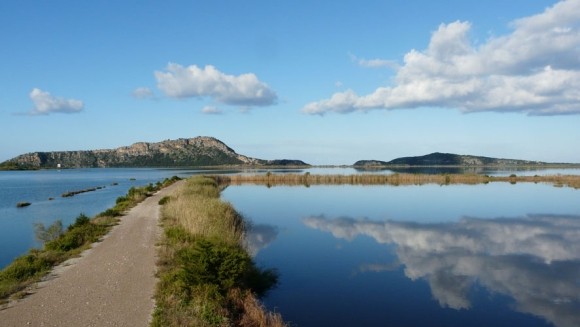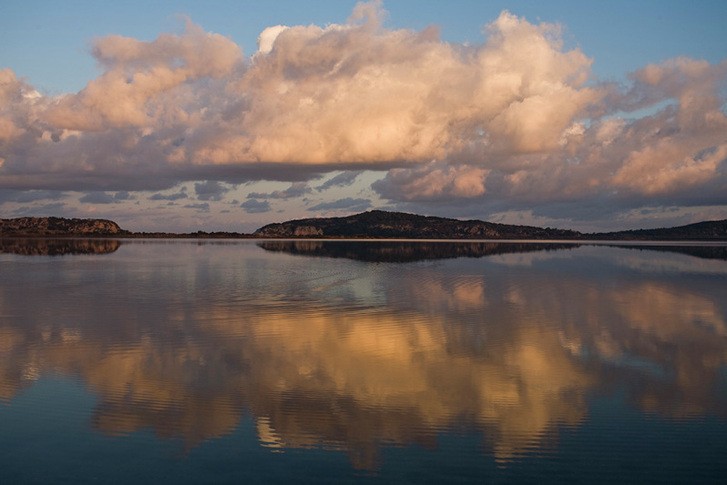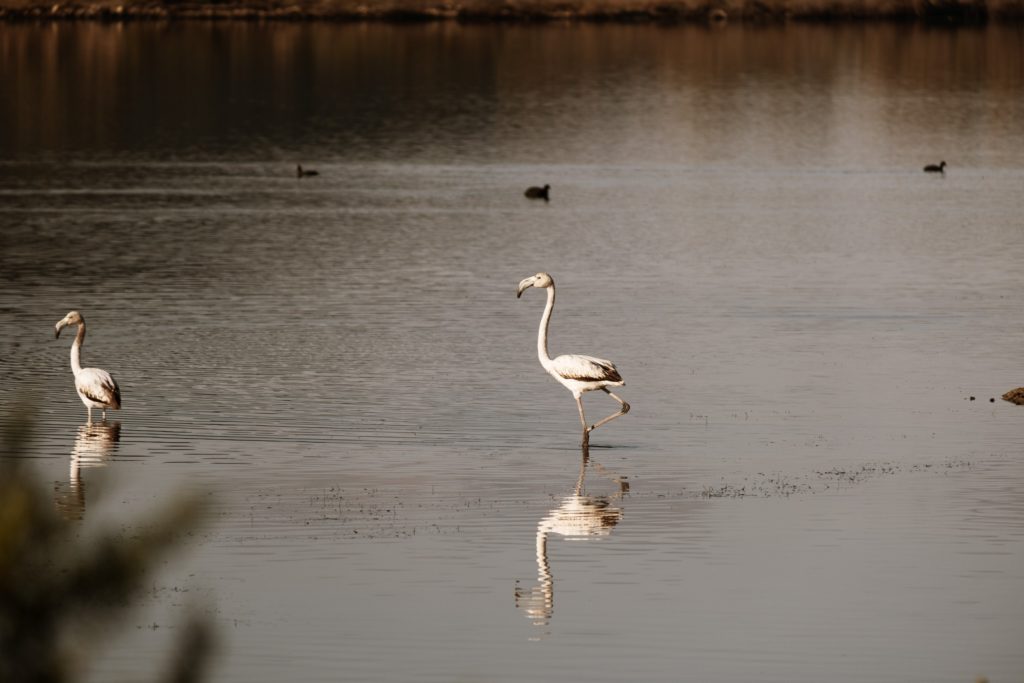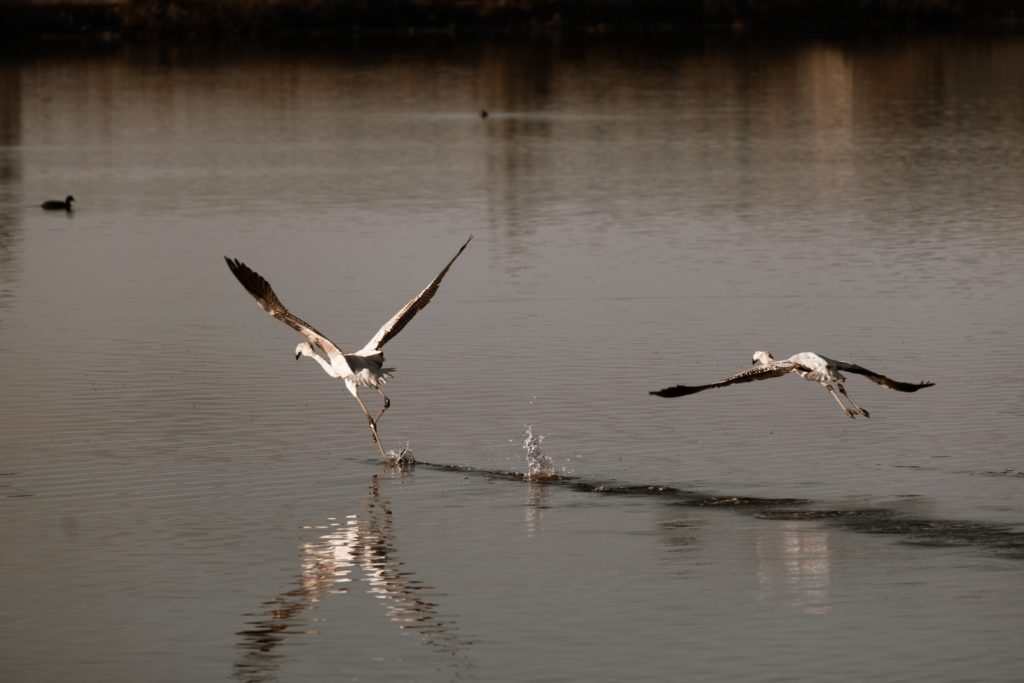The Gialova Lagoon, just a short walk away along the beach from Zoe Resort, is a brackish water coastal wetland. The Gialova Lagoon is notable, not only for its historical importance and the beautiful views but also for being the first important Balkan wetland that migratory birds come across in their return journey from Africa.
Rare species of birds can be found here, such as herons and flamingos, ospreys, Black-winged Stilts, avokettes, sandpiper, snipe, curlews, tartaric, terns, and the only kind of chameleon in Europe. The African chameleon changes color depending on his mood. The wetland of Gialova is a protected area since there are species that belong to the Greek endangered avifauna.

The History
During the 50’s attempts were made to drain the wetland, as was the general policy at the time for all wetlands, but thanks to the abundance of underground water the plans failed. Perfect example of the mistakes of the recent past, its size was reduced by 1/3 and its ecosystem damaged by canals, ditches and roads. These interventions altered the natural course of the rivers and reduced its productivity.
Nature, however, resists and the Gialova Lagoon remained a rich ecosystem that gives refuge to a high variety of inhabitants. As the time went by, more and more people understood the great value and the importance of the Gialova Lagoon’s wetland and actions were made to protect the territory. This is a place of unique ecological value and therefore it is 100% justified why it has been considered a protected area by Natura 2000.
In Gialova Lagoon there are over 270 species of birds, which include many rare species. Ospreys, Imperial Eagles, Marsh Harriers, Great White Egrets, Bitterns, Purple Herons, Glossy Ibises, terns, many ducks and waders and a multitude of passerines visit the wetland during migration and/or winter. Other species breed during the summer.
The Hellenic Ornithological Society implements since 1997 systematic actions for the protection and the promotion of the area. These actions include special management measures for the lagoon and the species that live there, environmental education actions and events to increase public awareness.

A Bird Paradise
This abundance of birds makes the Gialova Lagoon the most important wetland at the southern tip of the Balkan Peninsula.
Thousands of birds flying to Africa in autumn stop at the Gialova lagoon to rest and “refuel” for the last time before the long journey of 3000 km over the Mediterranean Sea and the Sahara desert. In spring they find there the southern-most European wetland to rest and feed again.

The importance of the Gialova lagoon for birds has been discovered only recently, and this is the reason why it is not famous (yet!). But this small wetland has a great advantage over the large wetlands of Northern Greece: its smaller size allows birdwatchers to spot most of the birds present there. A couple of hours in the watch-tower of the lagoon are enough to observe most of its inhabitants, from the impressive eagles to the elusive bitterns, etc.

The best period to observe birds at the lagoon is from September to May. Ruffs, Garganeys, Grey Herons, Little Egrets, Squacco Herons, Glossy Ibises, Curlews, Golden Plovers, Black-winged Stilts and Kingfishers are observed from August but it is not until the beginning of September that the king of the lagoon can be observed: the Osprey. Purple Herons, Marsh and Pallid Harriers, most species of terns, most waders, including Common and Marsh Sandpipers, Dotterels, Spotted Redshanks, Avocets and many more also arrive in September. The lagoon becomes a real paradise teeming with bird life!
In winter there are about 20,000 birds in the lagoon. Ducks and Coots are the most numerous birds, but there are other interesting species too, like the rare species of eagles: Imperial Eagle, Spotted Eagle and Osprey. Many Marsh and Hen Harriers join them. Flamingos are present in the wetland all year long, About 10 Bitterns are there in winter, and can be seen flying above the reed-bed especially just before dusk.
That makes the village of Gialova a great winter destination too!
We recommend visiting the lagoon in the early morning hours. There are three bird watching hides, and entrance is free.
Ecosystems of the Gialova Lagoon
A wetland is an ecosystem made up by a complex of smaller habitats, each characterized by water, soil and salt interaction, resulting in differentiated plant communities. A remarkable variety of strongly interdependent organisms develop, from invertebrates to fishes and a variety of birds, many of wich are rare and endangered today.
The Lagoon
The main lagoon is mostly inundated by the sea. Thus salt resistant animal and plant life prevail and are preyed upon by certain species of fish and birds. It is a feeding place for ducks, coots, cormorants, ferns, herons, ospreys and flamingoes.
The Marsh and the Reed bed
Freshwater flows into the marsh from the river Tiphiomitis. Freshwater species (or partly so, such as eel) find refuge in this habitat. The reed beds are a crucial breeding and feeding place for neonate fish. Many species of birds nest in the reeds (such as the Little Bittern) as the reed beds are undisturbed by humans and inaccessible to most predators. The marsh is also a favorite foraging ground for Glossy Ibises, grebes, Marsh Harriers and Black-winged Stilts which breed on the islets among the reeds’ clearings.
The Bottom Line
This beautiful ecosystem attracts many visitors and volunteers, not only for the respect and the love for the natural environment, but also to enjoy moments of relaxation and unique aesthetics. The natural beauty and the great hospitality of the people in Gialova, will make your Peloponnese Holiday an unforgettable experience!



